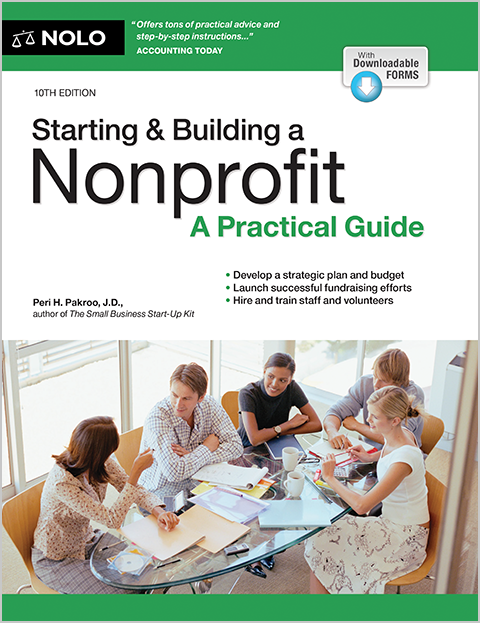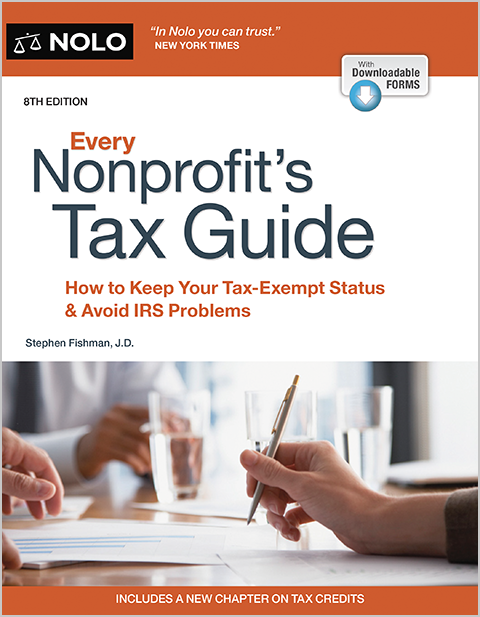Nonprofit corporations are entitled to grants, tax exemptions, and limited liability protection.
Nonprofit (or not-for-profit) corporations work well for all sorts of groups, from those promoting arts and music to those active in education, health, conservation, and community services. Often the reason for obtaining nonprofit status is simple—it's usually a requirement for obtaining funds from government agencies and private foundations. Other important benefits include tax-exempt status and personal liability protection.
Here's an overview of what types of groups should consider incorporating, and what lies ahead for them.
A Nonprofit's Tax-Exempt Status
Many nonprofit groups seek nonprofit corporate status to gain exemptions from federal and state income taxes. The most common federal tax exemption for nonprofits comes from Section 501(c)(3) of the Internal Revenue Code, which is why nonprofits are sometimes called "501(c)(3)s."
If your group obtains tax-exempt status, not only is it free from paying taxes on all income from activities related to its nonprofit purpose (see our article about tax concerns when your nonprofit earns money), but people and organizations that donate to the nonprofit can take a tax deduction for their contributions.
Nonprofit vs. Not-for-Profit: What's the Difference?
While nonprofits and not-for-profits have many similarities, these two types of organizations are distinct. Neither of these organizations is formed or operated for financial gain. But these organizations use their profits in different ways.
For nonprofits, any financial gain is returned to the organization for operating costs and distributed for 501(c)(3) purposes. Specifically, "nonprofit" typically refers to an organization that has received 501(c)(3) tax exemption. Nonprofits use their profits for the following purposes:
- charitable
- religious
- educational
- scientific
- literary, and
- testing for public safety.
For not-for-profits, any profit is put directly back into the organization. Not-for-profit organizations typically don't serve a public good but rather a social purpose. These organizations generally provide services to their members. Examples of not-for-profits include sports clubs, fraternities and sororities, trade associations, country clubs, credit unions, and homeowners associations.
Not-for-profits can still be federally tax-exempt. But they usually qualify for tax exemption under another section of the Internal Revenue Code and not under Section 501(c)(3).
Moreover, donations to nonprofits are usually tax-deductible. However, donations to not-for-profits aren't usually tax-deductible, except under specific circumstances.
In addition, nonprofits are generally held to higher transparency requirements and disclosure standards. For example, the public can inspect a nonprofit's application for 501(c)(3) tax-exempt status as well as its federal tax returns. Nonprofits must also disclose any limitations to a donor's tax-exempt contribution when the nonprofit provided the donor with something in exchange for the donation. A not-for-profit doesn't have these same strict requirements.
Filing Form 990 as a Nonprofit
Every year, most nonprofits must file an informational return with the IRS. This form is called "IRS Form 990." Importantly, religious institutions like churches, synagogues, and mosques aren't required to file this form.
Nonprofits use Form 990 to let the IRS know how the organization spends its money. Nonprofits must report their revenue, including contributions, grants, and investment income, as well as their expenses, including salaries, fundraising fees, and benefits.
Form 990 is due on the 15th day of the fifth month after the close of the nonprofit's fiscal year. For nonprofits that use the calendar year as their fiscal year, the deadline is May 15.
Protection From Personal Liability
Forming a nonprofit corporation normally protects the directors, officers, and members of the nonprofit from personal liability for the corporation's debts and other obligations. Called "limited liability," this protection shield ensures that anyone who obtains a judgment against the nonprofit can reach only the assets of the corporation, not the bank accounts, houses, or other property owned by the people who manage, work for, or participate in the business.
Believe it or not, there are still more reasons to incorporate your nonprofit group; read our article on the reasons to incorporate your nonprofit association for more details.
Who Should Consider Becoming a Nonprofit
The types of groups that typically seek nonprofit status vary widely. Here's a partial list of associations that might be eligible:
- childcare centers
- shelters for the homeless
- community health care clinics and hospitals
- museums
- churches, synagogues, mosques, and other places of worship
- schools
- performing arts groups, and
- conservation groups.
If your group isn't on this list, it doesn't mean you won't qualify for tax-exempt status. As long as your group's activity is charitable, educational, literary, religious, or scientific, and you meet the other requirements for tax-exempt status, you should be able to get a tax exemption.
Forming a Nonprofit Corporation
Forming a nonprofit corporation is very similar to forming a regular corporation: You must file articles of incorporation with the corporations division (usually part of the secretary of state's office) of your state government. But unlike regular corporations, you must also complete federal and state applications for tax exemptions.
After filing this initial paperwork, you'll create corporate bylaws, which lay out the operating rules for your nonprofit. Finally, you elect the initial directors of your nonprofit and hold an organizational meeting of the board. (To learn more, read our article about forming a nonprofit corporation.)
Who Plays Which Roles in Running a Nonprofit Corporation
Most nonprofit corporations are run by a board of directors—called "trustees" in some states. The directors' main role is to set policy for the nonprofit and oversee areas like finance, strategic planning, and management-level hiring.
A nonprofit corporation also has officers, who are usually appointed by the board of directors. Most nonprofit corporations have at least a:
- president
- secretary, and
- treasurer.
Some have other positions such as a vice-president or assistant secretary, depending on their needs and any state law requirements.
Officers might serve on the board of directors or they might be non-board members who play an active role in the day-to-day management of the nonprofit. For example, the person appointed president could serve as the executive director of the nonprofit in a paid staff position and be in charge of running the organization. Or the president could be the chair of the board (sometimes called the "president and chair of the board") whose primary role would be to run board meetings and oversee board matters. The same is true for the treasurer and secretary or any other officer position.
These positions can be filled by people in board advisory roles or by non-board members who are paid staff and actively running the corporation. A nonprofit's organizational structure is usually determined by the organization's articles of incorporation and bylaws.
Some states have rules about officer positions, such as:
- what officer positions are required
- whether one person can hold more than one role, and
- whether paid officers can serve on the board.
Once an organization gets big enough, the board typically authorizes the hiring of a full slate of salaried personnel, including program staff, administrative assistants, and development staff.
Following the Rules on Corporate Behavior
Nonprofit corporations must observe most of the same formalities as regular corporations. These formalities include:
- keeping good corporate records
- holding and preparing minutes of directors' (and possibly members') meetings, and
- maintaining a separate bank account.
Unlike regular corporations, a nonprofit corporation can't distribute any profits to its members, contribute money to political campaigns, or engage in lobbying activity, except in very limited circumstances. (For more information about recordkeeping and further details about what nonprofits can and cannot do, see how to protect your nonprofit corporation's tax-exempt status.)
How Are Nonprofits Funded?
Nonprofits can make money in a variety of ways. As long as these profits are used for charitable 501(c)(3) purposes, nonprofits have various fundraising options available to them. Some of the more common ways nonprofits are funded are through:
- Donations: Nonprofits solicit contributions in a range of ways. They hold special fundraising events, attend community gatherings, mail solicitations, network on social media, and go door-to-door. Nonprofits can solicit from individuals, businesses, and other groups and organizations. A nonprofit might ask for a one-time donation or recurring contributions. In exchange, people give to nonprofits in multiple ways. Some people give money (either in person, via mail, or online). Others contribute property, such as vehicles, clothing, food, and real estate.
- Legacy gifts: A "legacy gift" generally refers to a gift the nonprofit receives after the donor's death. Oftentimes, donors leave money or property to a charity through a will or living trust. After the donor dies, that money and property are then distributed to the named nonprofit with any specified restrictions. Nonprofits must follow any conditions or restrictions set on these gifts. For example, a donor might give $100,000 to a nonprofit that promotes affordable housing but specify that the gift is contingent on the organization using the donation toward multi-family housing. The nonprofit must then earmark that $100,000 donation for multi-family housing use.
- Earned income: Another way a nonprofit can make money is through selling goods and services and rental income. You've likely come across a nonprofit's garage sale, bake sale, or car wash. The organizer will usually specify that all profits will go to the nonprofit. Alternatively, some nonprofits make money from renting out buildings or spaces. For example, churches will often rent out their facilities during the week to groups and businesses.
- Grants: Some nonprofits apply for grants, usually from the government but sometimes from other charities or foundations. While grants can have high payouts, the application process can be arduous. The grant also usually comes with restrictions because grants are usually awarded for specific purposes. However, if your nonprofit is awarded a grant, you can build credibility amongst the community and attract other donors.
- Investments: Another way nonprofits can raise funds is through investments. Nonprofits can invest in stocks, bonds, savings and money market accounts, and other assets. Endowments are a common form of investment for nonprofits. An "endowment" is a gift to a nonprofit where the interest, but not the principal, on the gift is spent. Endowments are usually given for a specific purpose and have strict limits on spending so that the endowment can last long-term.
It's important to note that if your nonprofit plans to solicit funds, it usually must register with the state where it plans to fundraise. Some states don't require nonprofits to register but most do. It's important to know each state's fundraising registration rules before your nonprofit raises money.
Dissolving a Nonprofit Corporation
Nonprofits aren't actually owned by anyone and therefore can't be sold. If the directors of a nonprofit corporation decide to dissolve it, they must:
- pay off all debts and obligations of the nonprofit, and
- distribute all of its assets to another tax-exempt nonprofit corporation.
How you legally dissolve your nonprofit depends on your state's laws and your nonprofit's formation documents. However, in general, you'll need to:
- authorize the dissolution (usually by an affirmative vote by the board of directors)
- pay off any known debts
- provide notice to your creditors (known and unknown) of your intent to dissolve your nonprofit corporation
- distribute your nonprofit's assets to one or more 501(c)(3) organizations
- file a certificate or articles of dissolution, and
- file IRS Form 990 or IRS Form 990-EZ.
Along with IRS Form 990 or IRS Form 990-EZ, you must include a completed Schedule N (Liquidation, Termination, Dissolution, or Significant Disposition of Assets). You'll also need to include a copy of your nonprofit's certificate of dissolution or resolution to wind up and dissolve. When completing Form 990 or Form 990-EZ, you'll need to check the "Terminated" box in the header area on Page 1 of the return. For additional guidance, read Every Nonprofit's Tax Guide, by Stephen Fishman (Nolo), go to the IRS website, or consult with a tax professional.
Your state might have additional requirements. For example, you could need to receive clearance from your state's tax department before dissolving your nonprofit.
To learn more about your state's requirements, check out our state guide to dissolving your 501(c)(3) nonprofit corporation.
More Information About Nonprofits
For a guide through the process of getting your nonprofit up and running, get Starting & Building a Nonprofit: A Practical Guide, by Peri Pakroo (Nolo), which is filled with information, practical advice, and step-by-step instructions.
If you need help forming, running, or ending your nonprofit, talk to a business lawyer who has experience working with nonprofits. You can also find helpful resources through your state websites.
Ready to start your Nonprofit Corporation?



